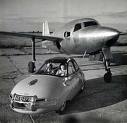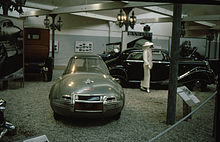Panhard Dynavia

The Panhard Dynavia is a prototype made by the former French car manufacturer Panhard in 1948.
Starting position
Panhard & Levassor was one of the oldest automobile manufacturers with an important commercial vehicle and armaments department. After the Second World War , production began with radically different vehicles. Instead of the previous, elegant and sometimes expansive luxury vehicles with large-volume slide engines , the company now relies on the brand name Panhard, lightweight construction, small two-cylinder engines and the lower middle class market segment . The first model of this new generation was the Panhard Dyna X , which appeared in 1945.
concept
For Panhard's longtime chief designer, Louis Bionier , it was a matter of exploring further options for reducing weight and improving aerodynamics . The Dynavia offered space for four people, but as a concept vehicle was less geared towards practicality and comfort. Two copies were built, components for a third were available but were not used.
technology
Bionier resorted to components of the Dyna X back. The air-cooled two-cylinder boxer engine with a displacement of 610 cm³ was also used . The tubular frame chassis was designed to be narrow, the body was clearly arched above. A particularly light material was chosen for the body: Duralinox , a rather exotic aluminum alloy with copper and magnesium . This made the Dynavia at 610 kg around a quarter (215 kg) lighter than the Dyna X and over 20 km / h faster.
Instead of the steering wheel shift of the Dyna , a gear lever was used, the handle of which was hidden under the dashboard; the driver had to switch "blind".
The Dynavia was built in Panhard's body shop, the former Atéliers Delaugère in Orléans .
Technical data and performance
- Engine: Air-cooled Panhard two - cylinder boxer engine , 610 cm³
- Power: 28 PS (20.5 kW)
- Power transmission: front wheel drive
- Transmission: manual, four-speed
- Weight: 610 kg
- Top speed: 130 km / h
- Consumption: approx. 4.2 liters / 100 km
design
The appearance is characterized by the extreme teardrop shape of the body and is vaguely reminiscent of an airplane. Bionier was one of the first to start from shapes in nature to make automobile bodies more efficient; in particular, he studied the aerodynamics of birds and the physique of fish. In addition, the design is also the result of experiments he carried out in 1947 with a 1: 5 scale model in the wind tunnel of the Institut Aérotechnique in Saint-Cyr, southwest of Paris . The drag coefficient is relatively small at 0.26.
The front is bulbous and contains, in addition to a centrally located fog light, two headlights hidden behind slots. Combination lights for turn signals and position light are mounted directly in front of the windshield. The front and rear windows are divided into two parts, all four fenders are only slightly outlined and the rear ends in a striking pointed tip with a single tail light at the end. The extremely long rear overhang is typical of aerodynamic vehicles. The doors are hinged at the back (" suicide door ") and in connection with the indicated panorama windows are not exactly easy to enter.
The dashboard is - due to its design - kept very low, covered with wood decor and provided with decorative elements made of brass. The two centrally arranged advertisements are inserted at an angle.
Appreciation
At the 1948 Paris Motor Show, the Dynavia attracted considerable attention.
In the following years Panhard consistently continued on the path he had chosen. Findings from the Dynavia project flowed into the development and lightweight construction remained an issue, even if later Panhard had a lower proportion of light metal. The combination of lightweight construction and aerodynamics led to appealing driving performance despite the small engine and was groundbreaking for the automotive industry. The consumption of 4 to 4.5 liters per 100 km is still remarkable today. The design, however, was too impractical for a utility car.
Whereabouts
One of the two vehicles was likely sold to a Panhard dealer in Grenoble. From there it got to Switzerland and was lost in an accident. The second vehicle came into their possession after Panhard was taken over by Citroën. It is now on permanent loan in the Cité de l'Automobile - Musée National - Collection Schlumpf in Mulhouse . Nothing is known about the whereabouts of the parts for a third Dynavia.
In 2005 the Dynavia was shown at the important Rétromobile trade fair in Paris.
Remarks
- ↑ also found the spelling "Bionnier"
- ↑ A photo-technical process called Di-Noc was probably used for this; that is now a brand name for self-adhesive foils
Individual evidence
- ↑ a b c d e f g h i j k motor-klassik.de: Driving report Panhard Dynavia
- ↑ a b c diseno-art.com: Strange Vehicles: Panhard Dynavia
- ^ Club Delaugère & Clayette; Company history ("Here")
- ↑ motorsnaps.com: delaugère et clayette company history
Web links
- motor-klassik.de: Panhard Dynavia in the driving report - The car that looks like an alien (accessed on September 6, 2012)
- Club Delaugère & Clayette website (French) (accessed September 5, 2012)
- motorsnaps.com: History of Delaugère & Clayette with 10 CV Voiturette (1902) and 20 CV Limousine (1904 ) (accessed September 5, 2012)
- panhard-club.de: Photos from the Panhard Dynavia (accessed on September 6, 2012)
- ultimatecarpage.com: Panhard Dynavia (English) (accessed September 6, 2012)
- diseno-art.com: Strange Vehicles: Panhard Dynavia (accessed on September 6, 2012)
- allsportauto.com: Panhard Dynavia at the Rétromobile 2005 (photos) (English) (accessed on September 6, 2012)



